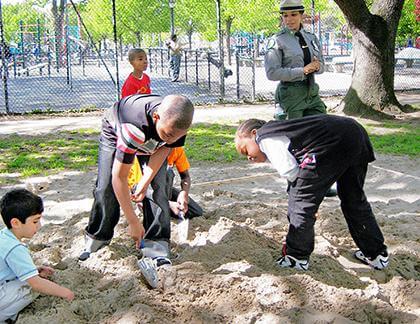By Ivan Pereira
Today Baisley Pond Park may not look like the environment where a prehistoric mammal made its home during the ice age, but experts said a mastodon spent its last years in the southeast Queens greenspace.
In celebration of the discovery of the woolly animal’s remains in the park, rangers held a special event Friday not only to instruct young students about the animals that roamed the earth during that period, but also to look back at the history of their park.
The city’s Urban Park Rangers set up several stations in the park designed to teach children about the mastodon. Sgt. Howard Kreft, the park ranger overseeing the event, said it was first held last year and had tremendous success getting students interested in prehistoric history and science.
“We teach them what to do to be a paleontologist,” he said.
Replicas of mastodon bones were displayed for kids to touch and observe and a representative from the Queens Public Library provided them with books on dinosaurs and other creatures from that era, while the American Museum of Natural History’s RV museum drew parents and their children interested in seeing other artifacts.
The event amazed many parkgoers who were coming in to enjoy the warm, spring weather, including Barry Kennerly, 40, who was walking through the area with his 3-year-old son, Barry Jr.
“It think it’s fun,” the Far Rockaway man said. “I like the way they have it all set up.”
One of the most interactive exhibits of the event was a mini-mastodon dig. Park workers buried pieces of a plastic model of a dinosaur skeleton in a sandbox and asked the kids to dig for the pieces.
“We want to teach about the natural history of mastodons and mammoths with hands-on learning,” Kreft said.
The children’s activity was similar to the way the real mastodon remains were discovered in the park more than a century ago. In 1857, two city workers found the bones accidentally while working in Baisley Pond, according to Kreft.
“They were dredging the pond at the time and they didn’t know what they found, so they called some scientists,” he said.
The paleontological experts discovered the remains were part of a mastodon and reconstructed it in a museum. The urban park ranger said the prehistoric animal probably thrived in the area more than 10,000 years ago, back when Queens had a completely different climate.
“People don’t associate [archeological] finds in urban areas like in New York City. It shows that the landscape is ever-changing,” said Kreft.
Reach reporter Ivan Pereira by e-mail at ipereira@cnglocal.com or by phone at 718-260-4546.



































